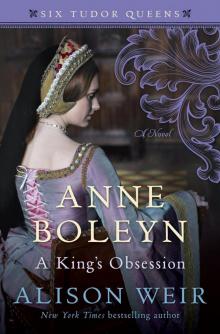- Home
- Alison Weir
Mary, Queen of Scots, and the Murder of Lord Darnley Page 27
Mary, Queen of Scots, and the Murder of Lord Darnley Read online
Page 27
The timing of the pardon, after the baptism, is significant. Mary must have known that Morton and his fellows had a score to settle with Darnley, the man who had betrayed them after Rizzio’s murder. Once they were back in Scotland, Darnley would be in a highly vulnerable position as the target for their vengeance, and he knew it. In allowing them to return to Scotland, Mary was in effect sealing his death warrant. It is hard to believe that she was not aware of this. She also knew that Maitland and Moray had been considering means of ridding her of Darnley, and that Morton and his friends— who had not stopped short of violence when Rizzio became a threat to them—were their allies; they had, moreover, at the very least, agreed to subscribe to the Bond in which the other Lords had resolved to render obedience to Mary but not to her husband. The outcome of such an alliance was almost a foregone conclusion, given that Darnley’s offences were much graver, and had had more far-reaching and ruinous consequences than had Rizzio’s, and also that, amongst the Scottish nobility, feuds were customarily settled—or prolonged—by the shedding of blood.
But Darnley had behaved in a far worse fashion towards Mary, and had reduced her to such a state of misery, distress and bitterness by his conduct that, as has been noted, she probably no longer cared what became of him, as long as he ceased to trouble her. Mary may have assuaged her conscience with the knowledge that, by insisting that the returning exiles keep well away from court for two years, she had limited the danger they posed to Darnley. The fact that she imposed this condition on them suggests that she was indeed aware of the danger. If, after she had taken such precautions, the Lords managed to take matters into their own hands, she could not be said to be responsible for it, and it could not touch her honour.
The news that his enemies were about to return to Scotland struck terror into Darnley. He was in an isolated position at court, having alienated most of the nobles, and had few supporters. It appears he took desperate measures to redeem himself with the exiled Lords. On 24 December, the same day on which Fawdonside had been expressly excluded from the general remission, a pardon for him passed separately under the Signet,47which suggests that it was granted by Darnley without Mary’s knowledge and after she had departed from Stirling to spend Christmas at Drummond Castle. That she could not bring herself to forgive Fawdonside for holding a pistol to her pregnant stomach is evident from the fact that she still regarded him as her enemy in 1568. Therefore it is virtually certain that she did not issue this pardon on Christmas Eve 1566. Darnley, moreover, had issued documents under the Signet on other occasions.
The gathering at Stirling broke up on Christmas Eve. Bedford went with Moray to St. Andrews, where he was honourably entertained as his guest for several days.48The Queen went without her husband to Drummond Castle near Crieff in Perthshire at the invitation of Lord Drummond. Buchanan later alleged that she there “sought solitude practically alone with Bothwell” and indulged in “filthy wickedness.” “They spent about a week in such close accommodation and intimate contact that everyone was bitterly offended by their contempt of reputation . . . In what order they were chambered during their stay, many found fault with, but dared not reprove. How lascivious also their behaviour was, it was very strange to behold.” Considering that “everyone” was shocked by their conduct, it is surprising that no other source refers to it. Furthermore, there is evidence that this was not just a private visit, since Mary attended to state business during her stay, and it is likely that she was attended by other Privy Councillors as well as Bothwell.
Meanwhile, William Hiegait had heard from one Cauldwell, a servant of the Earl of Eglinton, that Mary intended to have Darnley “apprehended and put in ward.” Hiegait confided this intelligence to the Laird of Minto, Provost of Glasgow, who alerted Lennox to the fact that, “at Craigmillar, the Queen and certain of her Council had concluded an enterprise to the great peril and danger” of his son, “which rested but only on the finishing of the christening and the departure of the ambassadors.” Lennox, in turn, warned Darnley, who instructed Hiegait to obtain more information from Cauldwell. According to Casket Letter II, “Minto sent him word that it was said that some of the Council had brought [Mary] a letter to sign to put him in prison and kill him if he did resist.” However, she had refused to sanction it.
It will be remembered that, at the time of the Craigmillar conference, there was talk of arresting Darnley for treason, although nothing had come of it. Had Mary really intended to have Darnley put in ward, she would surely have set about it before departing for Drummond Castle, rather than leaving her husband to his own dubious devices. But Darnley was taking no chances. Nor did he remain at Stirling to see if rumour spoke truth. According to Lennox, having received his father’s warning, and probably spurred on by his fear of the vengeful exiles, he stole away on Christmas Eve, without taking leave of anyone,49and made immediately for the safety of the Lennox heart-lands in Glasgow, “being fully resolved to have taken ship shortly after and to have passed beyond the sea.”50
13
“THE DAYS WERE EVIL”
DARNLEY WAS “HARDLY A MILE out of Stirling” when “a violent disorder suddenly struck every part of his body,” and when, after what must have been a nightmare journey, he arrived in Glasgow, “livid pustules broke out, accompanied by much pain and vexation in his whole body,” and “he was brought so low that nothing but death was expected.”1According to Buchanan, he had “black pimples all over his body, grievous sweat in all his limbs, and intolerable stink.” Herries says that, amongst other symptoms, “his hair fell off.” He lay ill for several weeks, wearing a white taffeta mask to cover the blisters. His incapacity effectively wrecked his plan to go abroad2 and thereby sealed his fate.
The nature of Darnley’s disease has been the subject of much debate: Bedford and Nau believed it to be smallpox, which was raging in Glasgow at that time and which usually commences with rigors, headaches, pains in the back and digestive disturbances. Within days, red pustules appear on the skin, mainly on the face and upper body. An attack of smallpox, with its recurring episodes of fever and exhaustion, usually lasts for about three weeks, after which the pustules have dried up and formed scabs that sometimes leave pitted scars, but Darnley was unwell for longer than that, and he had fallen ill before arriving in Glasgow, although he could of course have caught smallpox from one of the Lennox men who came from there—the incubation period is 12–14 days.
Yet it is almost certain that Darnley was suffering from something worse than smallpox. In his memoir of 1568, which was written in French, Bothwell initially asserted that the King had “la petite vérole” (i.e., smallpox), but later amended the last word in his own hand to read “roniole” (rognole), meaning an itch, a colloquial term for syphilis. The Diurnal of Occurrents and Lindsay of Pittscottie state candidly that the King was suffering from “a great fever of the pox,” which at that time could only mean syphilis. There is, moreover, evidence that he had perhaps had it for some time.
Syphilis is believed to have been brought to Europe by sailors returning from the New World in the late fifteenth century, and in the sixteenth, it swept through Christendom in epidemic form. The primary stage of syphilis is characterised by a painless chancre, or ulcer, on the genitals, which heals itself after a few days, leaving the sufferer with the impression that he is cured; during the secondary stage, which usually occurs after a period without any symptoms, there may be headaches, a sore throat, swollen glands, fever, aches in the bones, a mottled skin rash and sores in the mouth and throat. If syphilis is not treated at this stage, these symptoms may recur. The tertiary stage, which follows after a period of apparent health lasting from five to fifty years, produces more obvious skin lesions, heart disease, paralysis, insanity, blindness or deafness, and death.
It has been suggested that Darnley may have contracted syphilis during one of his early visits to France, when he was free from parental supervision. His attack of measles in 1565 was unusually prolonged and may have been the first
manifestation of the secondary stage, while the illness that struck him in late 1566 was probably a recurrence; the eruptions on his face, which some mistook for smallpox pustules, were more likely to have been a rash typical of “the acute inflammatory effects of syphilis when it first became epidemic.”3There may have been another recurrence in between: in March 1566, Randolph had reported that Darnley was thought to be suffering from leprosy.4He was certainly ill at that time, as a blue satin gown was made for him to wear in his sick-bed.5Darnley’s illness of late 1566 is unlikely to have been tertiary syphilis, as some writers have asserted, because there would have had to have been a gap of at least five years between that and the first symptoms of the second stage, and there is no record of Darnley being ill before the spring of 1565. Furthermore, some historians have claimed that Darnley was doomed to die of syphilis within a short time, but in fact he could have had fifty years or more of life left to him.
The recognised form of treatment for syphilis was mercury, which, when taken in oral form, caused necrosis of the gums, loosening of the teeth and pronounced halitosis. In Casket Letter II—which is probably in substance genuine—Mary refers to Darnley’s foul breath, which suggests that he was receiving mercury treatment at that time. Because syphilis was known to be contagious, a series of baths was recommended, and this was part of Darnley’s treatment. In 1928, at the request of Dr. Karl Pearson, Sir Daniel Wilson examined what is probably Darnley’s skull6and found pits in it that must have resulted from a serious disease. Smallpox does not cause such pitting, but an advancing secondary stage of syphilis does. It can also cause inflammation of the cranium, leading to hair loss.7
Inevitably, as often happened when royal persons fell ill, there were rumours of poison. Given the general enmity towards Darnley, the sudden onset of his illness and its ominous symptoms, that was hardly surprising. Knox and Buchanan claim that he had been given poison before leaving Stirling, and Buchanan states that Darnley’s physician, James Abernethy, a trustworthy doctor “of great skill and experience,” on seeing the blisters, “at once pronounced that he had been given poison.” Only “the strength of his youth” saved him.8According to Melville, it was said that the King “had got poison from some of his servants.” Robert Birrel also attributes the illness to poison, while Buchanan is emphatic: “That he was poisoned, it is certainly known.” Yet Lennox, surprisingly, makes no allegation of poison, nor is there any mention of it in the depositions of those alleged to have been involved in Darnley’s murder. However, in one of the latter, made by Nicholas Hubert, better known as “French Paris,” Darnley is described as being eaten up by a loathsome skin disease and a general foulness of body. Given all the evidence, the correct diagnosis is almost certainly syphilis.
It is inconceivable that Mary did not at some stage find out what ailed her husband. She was no innocent in such matters, as her censure of Archbishop Hamilton proves, and she must have been aware of what Darnley’s treatment betokened. Such knowledge must have intensified her revulsion against him, not the least because he had uncaringly exposed her and their child to the disease.
Meanwhile, in London, de Silva had received a disturbing communication from Margaret, Duchess of Parma, Philip II’s aunt and his viceroy in Brussels, informing him that de Alava, the Spanish ambassador in Paris, “had advised her that he had news of a plot being formed in Scotland against the Queen.”9
Coming around the same time as Hiegait’s revelations, de Silva’s report may well refer to Darnley’s plot to overthrow Mary and set either James or himself on the throne, with foreign aid. It should also be considered that information about the Lords’ machinations against Darnley, which a perceptive observer could have understood to be a means by which to bring Mary herself to ruin, might have infiltrated diplomatic channels. Whatever the basis of de Silva’s warning, Mary was in danger.
In militant mood, the General Assembly of the Church of Scotland convened on Christmas Day and made the Countess of Argyll do penance for participating in the Catholic baptism of the Prince. Two days later, indignant at Mary’s temerity at restoring Archbishop Hamilton’s powers, and fearful that it might signify her intention to force a Catholic revival, the Kirk petitioned the Council to stay the Queen’s warrant to the Archbishop. In response, Mary increased the clergy’s stipends, but it was not enough to halt the protests, and Moray warned her that she must comply with the law or risk serious trouble.10At the same time, her friends in Europe were warning her not to pursue an annulment for fear of alienating the English Catholics, many of whom viewed Darnley’s claim to the English throne as better than hers. Should she discard Darnley, he might become the focus for every plot against her.
Mary must have been in some turmoil when she left Drummond Castle for Stirling on 28 or 29 December.11On the 30th, still attended by Bothwell, she visited Tullibardine in Perthshire as the guest of her Comptroller, Sir William Murray, who was not only a friend of Bothwell but also a Lennox man, and had been knighted by Darnley. This visit may well have been made in order to build diplomatic bridges and charm Tullibardine into remaining loyal to his sovereign, whatever her relations with Darnley. Buchanan alleges that Mary and Bothwell openly continued their adulterous liaison at Tullibardine, but they are highly unlikely to have done so in the house of one of the Lennox affinity. Mary was still at Tullibardine on 31 December,12but returned to Stirling with Bothwell on that day or the next.13
On 1 January 1567, Moretta finally reached Paris, where he may have conferred with Mondovi and de Alava before pressing on to Scotland. Around this time, Moray and Bedford arrived back at Stirling.
Once Mary was back at Stirling, William Walker came to see her.14He told her what Hiegait had revealed to him of Darnley’s plot to crown the Prince. As she later told Archbishop Beaton, “At the hearing whereof you may well think we marvelled not a little; and seeing the matter of such importance, could not but insist to have further knowledge of the speakers and authors, that we might better understand the ground and fountain whereof it proceeded.” Walker said that Hiegait had “communicated the matter to him, as it appeared, to gratify us, whereupon, we took occasion to send for Hiegait.” But once confronted with the Privy Council, both alone and in the presence of Walker, he denied “that he had ever talked with the said Walker on any such subject,” and admitted only to having heard from Cauldwell a rumour that Darnley was to be put in ward. Mary ordered her Council to examine Cauldwell also, but he, in turn, denied having said anything at all to Hiegait. Mary was therefore unable to get to the bottom of the matter, and had to content herself with reproving both men for their “groundless talk.”15 Yet her letter to Beaton, written on 20 January, shows that she thought it anything but groundless.
On 2 January, Mary held a Council at Stirling, which was attended by Moray, Huntly, Argyll, Maitland and other Lords, but not by Bothwell, who had left court, probably on that very day, for Dunbar, where he purposed to await the arrival of Morton in Scotland. He had important matters to discuss with him.
Mary remained at Stirling for a few days before visiting Seton.16She was eagerly awaiting the conference at which her title to the English succession would, she hoped, be finally acknowledged, and on 3 January, she wrote to her “dearest sister” Elizabeth to thank her for her good intentions towards her in this respect.17Bedford left Stirling with this letter on 5 January,18and on 5 February, Cecil informed Sir Henry Norris in Paris that Bedford had brought him “good report from the Scottish Queen of her good disposition to keep peace and amity with the Queen’s Majesty.”19It was unlikely that Mary would have prejudiced her hopes in England by plotting to murder Darnley.
On Twelfth Night, 6 January, Maitland and his long-standing sweetheart, Mary Fleming, were finally married, in the chapel royal at Stirling.20This marriage to one of Mary’s closest attendants served to identify Maitland more closely with the Queen’s interests.
Earlier that day, a seemingly innocent incident had taken place. A passport was issued, bearing Mary’s sig
nature, permitting one Joseph Lutini, an Italian in her service, to proceed to France on the Queen’s affairs.21It had been made out and countersigned by her secretary, Joseph Rizzio, who was a friend of Lutini, a fellow Catholic. Rizzio and others also lent Lutini money for his journey. All seemed straightforward and above board, but it was to prove to be anything but, for Lutini’s business abroad was nothing to do with the Queen, yet he had managed to coerce Rizzio into forging Mary’s signature on the passport. Before that could be discovered, however, Lutini was on his way to Berwick, possibly hoping to meet up there with Moretta.
Unaware of this, Mary was coming to the conclusion that it was unwise to alienate the Kirk. On 7 January, at Moray’s urging, she deprived Archbishop Hamilton of his consistorial jurisdiction22and, in so doing, said goodbye to any prospect of an annulment of her marriage. The only body in Scotland that now had the power to grant a divorce was the civil—and Protestant—Court of Session. Mary had effectively cut off her one lawful route of escape from her marriage to Darnley. The only honourable option left to her was reconciliation. The other option was murder.
On 9 January, Bedford reported that, although Darnley was full of the smallpox, relations between him and the Queen were “nothing amended.” Nevertheless, she had sent her personal physician to him.23The Book of Articles later maliciously asserted “that she refused to send her mediciner or apothecary to visit him”; Buchanan claimed he had been sent for, “but she herself forbade him to go because she feared that, by his attentions, the sick man might escape death.” Not only did Mary send her personal physician, she also gave orders for some of her linen to be cut into ruffs to edge the King’s nightshirt.

 Richard III and the Princes in the Tower
Richard III and the Princes in the Tower Britain's Royal Families: The Complete Genealogy
Britain's Royal Families: The Complete Genealogy The Lady in the Tower: The Fall of Anne Boleyn
The Lady in the Tower: The Fall of Anne Boleyn Six Wives of Henry VIII
Six Wives of Henry VIII Elizabeth of York: A Tudor Queen and Her World
Elizabeth of York: A Tudor Queen and Her World Captive Queen
Captive Queen Innocent Traitor
Innocent Traitor The Marriage Game
The Marriage Game A Dangerous Inheritance
A Dangerous Inheritance Katherine of Aragón: The True Queen
Katherine of Aragón: The True Queen The Marriage Game: A Novel of Queen Elizabeth I
The Marriage Game: A Novel of Queen Elizabeth I Princes in the Tower
Princes in the Tower Anne Boleyn: A King's Obsession
Anne Boleyn: A King's Obsession Traitors of the Tower
Traitors of the Tower Mistress of the Monarchy: The Life of Katherine Swynford, Duchess of Lancaster
Mistress of the Monarchy: The Life of Katherine Swynford, Duchess of Lancaster Queens of the Conquest: England’s Medieval Queens
Queens of the Conquest: England’s Medieval Queens Eleanor of Aquitaine: A Life
Eleanor of Aquitaine: A Life Mary, Queen of Scots, and the Murder of Lord Darnley
Mary, Queen of Scots, and the Murder of Lord Darnley Henry VIII: The King and His Court
Henry VIII: The King and His Court Queen Isabella: Treachery, Adultery, and Murder in Medieval England
Queen Isabella: Treachery, Adultery, and Murder in Medieval England Katheryn Howard, the Scandalous Queen
Katheryn Howard, the Scandalous Queen Arthur- Prince of the Roses
Arthur- Prince of the Roses The Wars of the Roses
The Wars of the Roses Eleanor of Aquitaine: By the Wrath of God, Queen of England
Eleanor of Aquitaine: By the Wrath of God, Queen of England Mary Boleyn: The Great and Infamous Whore
Mary Boleyn: The Great and Infamous Whore Jane Seymour: The Haunted Queen
Jane Seymour: The Haunted Queen Anna of Kleve, the Princess in the Portrait
Anna of Kleve, the Princess in the Portrait Lancaster and York: The Wars of the Roses
Lancaster and York: The Wars of the Roses The Grandmother's Tale
The Grandmother's Tale The Princess of Scotland (Six Tudor Queens #5.5)
The Princess of Scotland (Six Tudor Queens #5.5) The Lady Elizabeth
The Lady Elizabeth Katherine Swynford: The Story of John of Gaunt and His Scandalous Duchess
Katherine Swynford: The Story of John of Gaunt and His Scandalous Duchess The Curse of the Hungerfords
The Curse of the Hungerfords The Lost Tudor Princess: The Life of Lady Margaret Douglas
The Lost Tudor Princess: The Life of Lady Margaret Douglas Eleanor of Aquitaine
Eleanor of Aquitaine Mistress of the Monarchy
Mistress of the Monarchy The Lost Tudor Princess
The Lost Tudor Princess Henry VIII
Henry VIII Anne Boleyn, a King's Obsession
Anne Boleyn, a King's Obsession A Dangerous Inheritance: A Novel of Tudor Rivals and the Secret of the Tower
A Dangerous Inheritance: A Novel of Tudor Rivals and the Secret of the Tower Elizabeth of York
Elizabeth of York Katherine of Aragon, the True Queen
Katherine of Aragon, the True Queen Katherine Swynford
Katherine Swynford Wars of the Roses
Wars of the Roses Queens of the Conquest
Queens of the Conquest Mary Boleyn
Mary Boleyn Britain's Royal Families
Britain's Royal Families The Tower Is Full of Ghosts Today
The Tower Is Full of Ghosts Today Life of Elizabeth I
Life of Elizabeth I Anne Boleyn A King's Obssession
Anne Boleyn A King's Obssession Lancaster and York
Lancaster and York Jane Seymour, the Haunted Queen
Jane Seymour, the Haunted Queen Queen Isabella
Queen Isabella The princes in the tower
The princes in the tower